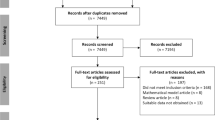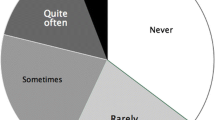Abstract
Social grooming in 19 adult stumptailed macaques (a dominant male and 18 females) was studied by focal sampling and scanning methods. Significant individual differences were found with respect to both active and passive grooming intensity, active grooming being a more variable parameter. Individual preferences in partner choice are very strong, but among the factors examined, age was the only one influencing these preferences. Neither social rank nor kinship were significant. The proportion of active and passive contacts shows marked individual differences. Yet, there is a positive association between performed and received grooming. The “extortion hypothesis” is not supported by our results: high-ranking individuals performed on the average more, and received relatively less grooming than low-ranking ones. High grooming performance of the dominants may secure group integrity in species with a “soft” dominance style.
Similar content being viewed by others
References
Altmann J., 1980.Baboon Mothers and Infants. Harvard University Press Cambridge.
Boccia M.L., 1989.Comparison of the physical characteristics of grooming in two species of macaques (Macaca nemestrina and M. radiata). Journal of Comparative Psychology, 103: 177–183.
Butovskaya M.L., 1987.Evolution of social behavior in primates as a basis for human evolution (in Russian). Sovetskaya Etnografiya, 1: 52–69.
Butovskaya M.L. and Ladygina O.N., 1989.Support and cooperation in agonistic encounters of stumptailed macaques (Macaca arctoides). Anthropologie, 27: 73–81.
Butovskaya M.L. and Ladygina O.N., 1990.Kinship and agonistic behavior in a group of stumptailed macaques (in Russian). Bulletin of the Moscow Society of Naturalists, 95: 3–19.
Carpenter C.R., 1964.Neturalistic Behavior of Nonhuman Primates. Pennsylvania State University Press, University Park.
Davison M.L., 1983.Multidimensional Scaling. John Wiley and Sons, New York.
De Waal F.B.M., 1989.Food sharing and reciprocal obligations among chimpanzees. Journal of Human Evolution, 18: 433–459.
De Waal F.B.M. and Luttrell L.M., 1986.The similarity principle underlying social bonding among female rhesus monkeys. Folia Primatologica, 46: 215–234.
De Waal, F.B.M. & Luttrell, L.M., 1988.Mechanisms of social reciprocity in three primate species: symmetrical relation characteristics or cognition? Ethology and Sociobiology, 8: 101–118.
Dietz E.J., 1983.Permutation tests for association between two distance matrices. Systematic Zoology, 32: 21–26.
Dow M.M. and Cheverud J.M., 1985.Comparison of distance matrices in studies of population structure and genetic microdifferentiation: quadratic assignment. American Journal of Physical Anthropology, 68: 367–373.
Dunbar R.I.M., 1988.Primate Social Systems. Cornell University Press, Ithaca.
Easley S.P., Coelho A.M. Jr. and Rutenberg G.W. 1990.Multidimensional scaling of social relationships in baboons. International Journal of Anthropology, 5: 309–324.
Easley S.P., Coelho A.M. Jr. and Taylor L.L., 1989.Allogrooming partner choice, and dominance in male anubis baboons. American Journal of Physical Anthropology: 8O: 353–368.
Hausfater G. and Sutherland R., 1984.Little things that tick off baboons. Natural History, 93: 54–61.
Hemelrijk C.K., 1990.Models of, and tests for, reciprocity, undirectionality and other social interaction patters at a group level. Animal Behavior, 39: 1013–1029.
Lopez-Vergara L., Santillan-Doherty A.M. Mayagoitia L. and Mondragon-Ceballos R., 1989.Self and social grooming in stump-tailed macaques: effects of kin presence or absence within the group. Behavior Proceedings, 18: 99–106.
Mc Kenna J.J., 1978.Biosocial functions of grooming among the common Indian langur monkey (Presbytis entellus). American Journal of Physical Anthropology, 48: 503–510.
Ranson T.W. and Ransom B.S., 1971.Adult male-infant relations among baboons (Papio anubis). Folia Primatologica, 16: 179–195.
Seyfarth R.M., 1977.A model of social grooming among adult female monkeys. Journal of Theoretical Biology, 65: 671–698.
Seyfarth R.M., 1983.Grooming and social competition in primates. In (R.A. Hinde, ed.). Primate Social Relationships, pp 182–189 Sinauer Associates, Sunderland.
Silk J.B., 1982.Altruism among female Macaca radiata: explanations and analysis of patterns of grooming and coalition formation. Behavior, 79: 162–188
Smuts B.B., 1985.Sex and Friendship in Baboons. Aldine, New York
Sneath P.H.A. and Sokal R.R., 1973.Numerical Taxonomy. W.H. Freeman and Company, San Francisco.
Sokal R.R. and Rohlf F.J., 1969.Biometry. W.H. Freeman and Company, San Francisco.
Stammbach E. and Kummer H., 1982.Individual contributions to dyadic interaction: an analysis of baboon grooming. Animal Behavior 30: 964–971.
Stuart A., 1955.A test for homogeneity of the marginal distributions in a two-way classification. Biometrika, 42: 412–416.
Thierry B., Gauthier C. and Peignot P., 1990.Social grooming in Tonkean macaques. International Journal of Primatology, 11: 357–374.
Wagner S.S., 1970.The maximum-likelihood estimate for contingency tables with zero diagonal. Journal of the American Statistical Association, 65: 1362–1383.
Zumpe D. and Michael R., 1986.Dominance index: a simple measure of relative dominance status in primates. American Journal of Primatology, 10: 291–300.
Author information
Authors and Affiliations
Rights and permissions
About this article
Cite this article
Butovskaya, M.L., Kozintsev, A.G. & Kozintsev, B.A. The structure of affiliative relations in a primate community: Allogrooming in stumptailed macaques (Macaca arctoides). Hum. Evol. 9, 11–23 (1994). https://doi.org/10.1007/BF02438136
Received:
Accepted:
Issue Date:
DOI: https://doi.org/10.1007/BF02438136




